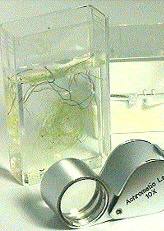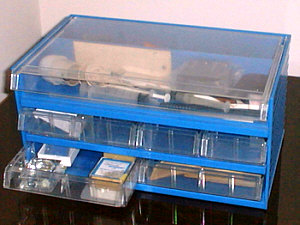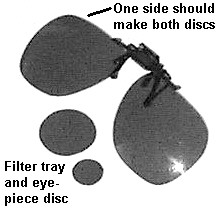Editor's note: I'm sure we've all acquired tips, techniques, 'tricks of the trade' or perhaps made simple gadgets while pursuing the fascinating hobby of amateur microscopy. Why not share some of yours with us? I'm sure they'll be of interest to others who may not have come across them. Just send us a short note in an e-mail (contact in footer), enclosing a scanned picture or drawing if you wish and we would be pleased to compile, upload and acknowledge your contributions.
 Observing
pond-life: Pond collections containing water fleas, cyclops and other
multicellular life can be observed in a rectangular glass or plastic container
that is narrow, such as a 'Ti-Tac' mint container (shown right). The use
of a 10X or 15X magnifier reveals a great deal but use a 5X to 7X magnifier
for a more "general" view.
Observing
pond-life: Pond collections containing water fleas, cyclops and other
multicellular life can be observed in a rectangular glass or plastic container
that is narrow, such as a 'Ti-Tac' mint container (shown right). The use
of a 10X or 15X magnifier reveals a great deal but use a 5X to 7X magnifier
for a more "general" view.
Another method of observation is to use a Petri dish or something similar and use a stereo microscope (20X) to observe your collected specimens.
When collecting from ponds, be sure to obtain some
of the algae or other pondweed if present. Much water life clings to this
material.
 Containers
to keep bits and pieces for microscopy: Microscope slides, cover slips,
test tubes, jars, forceps, pipettes, magnifiers and other assorted lab
supplies can all be kept handy in one container. I use a 'Plano' fishing
tackle box. (Plano is a company that manufactures plastic containers and
well constructed tackle boxes; it is located several miles west of my home
in the town of Plano, Illinois.) The tackle box has an open area on top
with a hinged lid. Beneath that are about four pull-out drawers that can
hold smaller items. Larger items are stored in the top of the box—mounting
fluids, microscope slide boxes, magnifiers, extra objectives or eyepieces
and assorted sundries. The small plastic toolboxes (shown right can also
be used).
Containers
to keep bits and pieces for microscopy: Microscope slides, cover slips,
test tubes, jars, forceps, pipettes, magnifiers and other assorted lab
supplies can all be kept handy in one container. I use a 'Plano' fishing
tackle box. (Plano is a company that manufactures plastic containers and
well constructed tackle boxes; it is located several miles west of my home
in the town of Plano, Illinois.) The tackle box has an open area on top
with a hinged lid. Beneath that are about four pull-out drawers that can
hold smaller items. Larger items are stored in the top of the box—mounting
fluids, microscope slide boxes, magnifiers, extra objectives or eyepieces
and assorted sundries. The small plastic toolboxes (shown right can also
be used).
 Multi-coloured
microscopy: For viewing objects such as certain crystals under polarized
light, cut a disc from a piece of Polaroid material and place on top of
the microscope light source (if in-built), or over the mirror if an external
light source. Then cut a disc from the Polaroid material that will fit
inside the ocular. Just unscrew the ocular and place the material inside
so it fits tight up against the stop. I use a separate wide-field 10X ocular
for this so it is always ready for polarization use. By turning the ocular,
you achieve various effects with polarization. Works great. (Editor's
note: A cheap source of Polaroid filters are the plastic clip-on
Polaroid sunglasses for spectacles; shown right. If preferred, the filter
can be placed on top of the eyepiece held in place with e.g. a tiny piece
of Plasticene. This places less than optically perfect filters out of the
plane of focus and also avoids the need for the filter to be scrupuluously
dust free.)
Multi-coloured
microscopy: For viewing objects such as certain crystals under polarized
light, cut a disc from a piece of Polaroid material and place on top of
the microscope light source (if in-built), or over the mirror if an external
light source. Then cut a disc from the Polaroid material that will fit
inside the ocular. Just unscrew the ocular and place the material inside
so it fits tight up against the stop. I use a separate wide-field 10X ocular
for this so it is always ready for polarization use. By turning the ocular,
you achieve various effects with polarization. Works great. (Editor's
note: A cheap source of Polaroid filters are the plastic clip-on
Polaroid sunglasses for spectacles; shown right. If preferred, the filter
can be placed on top of the eyepiece held in place with e.g. a tiny piece
of Plasticene. This places less than optically perfect filters out of the
plane of focus and also avoids the need for the filter to be scrupuluously
dust free.)
Darkfield without a condenser: Darkfield is a fascinating way to observe objects such as pond life, diatoms, crystals, insect parts, etc. For microscopes without an Abbe condenser or one having a substage five-opening hole disk diaphragm, you can still achieve darkfield illumination by cutting a rectangle out of a piece of clear plastic, placing a round black disk (from black paper) in the center and attaching it directly beneath the stage with tape—preferably gaffers tape, which does not leave a sticky residue. Experiment with the size of black disc to achieve the best result.
First, look into the eyepiece at a subject and position the plastic and disk until darkfield is achieved, then tape in place. This works, and I have taken excellent darkfield color slides this way.
Of course, it is easier to have an Abbe condenser.
When I use a 'scope with a condenser, I usually just leave the plastic
and centered disk in the filter holder and just swing it out when I need
brightfield. I use a darkfield stop of about 12-15 mm approximately on
the filter tray and it works quite well with the 4X and 10X objectives
with 10X widefield ocular. I guess a bigger stop is used with higher magnifications,
but with live material the 4X to 10X objectives work best. Also, it is
interesting to try different filters—red, yellow,
blue, green, etc. when using brightfield or darkfield illumination.
Eyepieces: I also recommend 10X widefield
eyepieces with high eyepoint. I have one for each of my 'scopes.
Contributions by Chuck
Huck, comments welcomed.
Compilation and images by Dave Walker.
For readers interested in further details/examples of darkfield or Polaroid filter useage in microscopy, type 'dark' or 'polar' into the keyword search engine of the Micscape Article Library; link below.